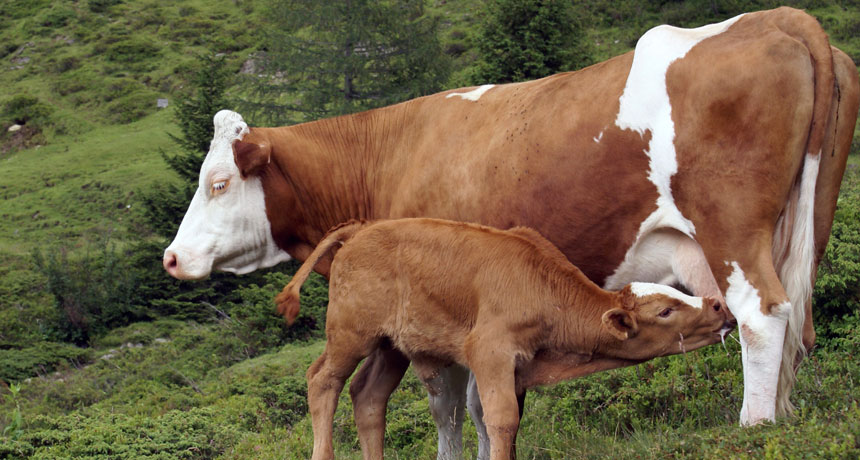Does breast milk come in pink and blue?

A new analysis of cows shows that mamas make more milk for daughters. Other studies have hinted that human moms produce different milk for sons than for daughters, so perhaps lactating women also boost production for daughters.
DaveLongMedia/iStockphoto
- More than 2 years ago
I love eavesdropping on people’s overly detailed coffee orders. You, sir, with the temerity to order a skinny split quad shot latte no whip no foam, with a side of lemon? Your extreme customizing just made my day.
Such personalization was running through my mind as I read a recent study on cows. It turns out that another beverage is also subject to the specific, exacting standards of its drinker: milk. And the customer’s bossy demands seem to start before he or she is born.
Heifers produce more milk for daughters than sons, Katie Hinde and colleagues report February 3 in PLOS ONE. When a cow gives birth to her first female, she makes about 1.6 percent more milk than she would have for a son, Hinde and colleagues found by analyzing the dairy records from a million and a half cows. And because calves born at dairy farms are taken away from their mothers soon after birth, the female calves’ requests to “make me more milk” must have come during pregnancy.
Another interesting finding: The first pregnancy had an outsized effect on the cow’s future milk production. Cows that had sons first saw a slight bump in production when they got pregnant with a daughter, but didn’t catch up to the cows that had a daughter followed by a son. The first born daughter set the mom’s milk-making machinery on high, and that’s where it stayed for subsequent pregnancies.
Hinde and her colleagues have all sorts of fascinating ideas about why this sex disparity evolved, and she describes many of them on her hilarious blog, Mammals Suck…Milk!.
My interest in the study is admittedly more self-centered. As someone who, multiple times a day, dissolves parts of my body to feed my daughter (thanks to Hinde for that new favorite — and frankly, terrifying — description of breast feeding), I wondered what the chances are that women, like cows, make more milk for their daughters. “Really good,” she assures me.
Some small studies have hinted that lactating women produce different milk for sons than daughters. In some cases, sons seem to get milk that contains more protein and fat than daughters, but no one has carefully looked at the amounts of milk produced, Hinde says. It’s quite possible that like heifers, lactating women also boost production for daughters.
One of the ways female fetuses might be telling their moms to make more milk is through hormones. Because many of the hormones in a female fetus are the same as the ones in her mother, there may be an additive effect. And because humans have placentas that allow a lot of mixing and mingling, it’s probable that estrogens from the Baby V might have crept into my pregnant body, ramping up my milk machinery.
Although there’s lots we don’t know about breast milk, we do know that the stuff is chock full of healthy goodness, as my colleague Jessica Shugart recently pointed out. (Fun fact: A breast feeding newborn may drink 10 billion live immune cells a day.) But one of the most amazing things about breast milk — and one of the most mysterious — is that it changes based on the needs of the baby.
“Breast milk is individualized and unique and tailored to that individual baby,” Hinde says. Breast milk produced during the night is different from breast milk in the day. Breast milk for a 2-week-old baby is different from milk for a 1-year old. Breast milk produced when mom and baby are fighting a cold probably has specially formulated antibodies. And now, breast milk for girls might be different from breast milk for boys.
Knowing more about the vagaries of milk making won’t just benefit dairy farm owners. It will encourage societies to help women breastfeed and will help women who don’t, for whatever reason. “We owe it to them to have the best formula available,” Hinde says. Knowing the exact specifications of breast milk could help formula makers build better products.
Right now, formula is better than it has ever been, but it’s still limited. It doesn’t offer the dazzling variety that may best nourish our babies. Imagine walking down the baby aisle and choosing a formula made for a 7-month-old baby boy who needs a drink right before bed. Admittedly, that’s a tough order to fill. But maybe the idea is no crazier than ordering a side of lemon with a coffee.







